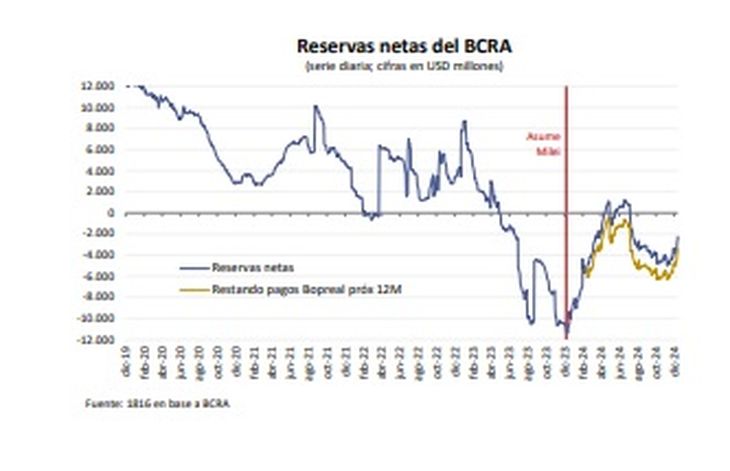The Argentine sovereign bonds They record an increase of almost 100% so far this year (+94% YTD, for its acronym in English). And the projection for the Argentine debt is more than positive, but, in the city, there is already discussion of the dismantling of positions in globals and bonars to look for attractive returns in other instruments, based on the normalization of certain variables, therefore The question that arises is whether the time has come to rotate portfolios.
It happens that this exceptional behavior of bonds occurred in a context of instability, but it should not be the norm in a more stable market. With a country risk that is around 700 basis points (bp), a normalization in yields and a reduction in the volatility of sovereign debt securities is evident. In simple terms, this implies lower returns in the future.
Thus, and unlike other emerging bonds, Argentine debt maintains a solid performance thanks to its good local fundamentals, such as the current and fiscal account surplus. Furthermore, the rerating of Fitch Ratings, which went from CC to CCC, reinforces confidence in the bonds, with room for further increases from a macroeconomic perspective.
“The drivers to follow include purchases of reserves, sustainability of financial surpluses and a rebound in activity and salaries, consolidating a positive outlook for the government in view of next year’s elections,” they point out from the Invest in the Stock Market Group (IEB). .
Bonds in dollars: what the city analyzes
As analyzed Personal Investment Portfolio (PPI) the Globals cut the tenuous positive streak that they had last week and fell 0.3%, which brought their weighted price above to US$68.7. The losses occurred along the entire curve: the long section suffered the most, with the Global 20398 (GD38) falling 0.5% and the Global 2046|(GD41) and global 2046 (GD46) falling 0.5%. 4%.
“In this way, the country risk advanced 5 basis points to 663. This time our sovereigns were not oblivious to the international trend or local noises. On the one hand, emerging markets continue to digest the latest FED rate decision of the Wednesday and, consequently, the EMB ETF, composed of emerging and frontier bonds, fell 1.9% Although the Federal Reserve cut the monetary policy rate by 25 basis points, the outlook for declines. 2025 was not so encouraging,” analyzes the broker.
1816.jpg
The global curve is flat, with an Internal Rate of Return (IRR) of 10%, due to improvements in repayment prospects for next year, as IEB points out. “If we go towards a flat curve at 9%, which would imply a country risk of 500 bp, if the current yield of the 10-year treasury (US Treasury bonds) is taken into account, the debt has upside”, they explain.
Thus, the market shows solid confidence regarding the Government’s ability and willingness to meet its debt commitments. This perception is reflected in the downward shift of the sovereign yield curve and places them at similar rate levels, and even slightly lower, than those of the Bopreales.
Currently, Bopreales present competitive rates: Series 1 B yields 14%, while Series 3 offers 11.6%. Other securities, such as Series 1 C and Series 1 D, are positioned at 11.5% and 10.6%, respectively, in line with or just below sovereign yields, which range between 11.5% and 11%. along its curve.
It happens that sovereigns offer a slight positive spread, their attractiveness may depend on the investor’s horizon. Some Bopreals have a shorter duration than the AL29 and AL30, making them less ideal for channeling expectations of further spread compression.
It should be remembered that the Bopreales were created in a context where the Government sought to improve internal financing conditions, offer attractive instruments in dollars and manage the sovereign risk perceived by investors.
Regarding the Globales curve, its prices abroad align with those of countries with a CCC+ rating, such as Congo and Ecuador. However, in the short tranches they are similar to those with a B- rating, such as Egypt and Nigeria, which shows a greater compression of valuations compared to, for example, the beginning of the year.
For their part, the Bopreales, dollar securities issued by the BCRA at the beginning of the current administration, maintain a perception of lower risk thanks to the solid credit history of the Central Bank with the Treasury. Despite this, the yields of both instruments have converged because the final issuer continues to be the National State.
The performance of Bopreales has been positive this year, driven by a general improvement in the market. Still, investors should consider both differences in duration and global market conditions when evaluating their strategy between these instruments and sovereign bonds.
As the consulting firm 1816 recalls, dollar bonds extended their annual gains in recent days, which takes the drama out of the recent volatility of the currency. In three weeks, interest and capital of Globales are paid and the reinvestment of coupons could be the catalyst that leads them to yield single digits, although it is important that the international context accompanies it.
“Long bonds continue to have greater upside in almost all normalization scenarios (they also have less downside in bad scenarios), but the difference with 2030 is increasingly smaller,” he adds. The fixed rate curve corrected the day before yesterday on the third day of strong rise in the FX, but the Boncap Feb-26 remains at 2.35% TEM (vs. 2.63% of the 11/11 lici). For conservative portfolios it is still attractive to set the ajun-25 rate (2.56% TEM vs 2.40% at 1d) and in the very short section we like the Boncer T2X5 (the inflation gave-23 quhyguala its TEA to that of the $14 F5 is just 1.9%)”, he concludes.
Source: Ambito
I am an author and journalist who has worked in the entertainment industry for over a decade. I currently work as a news editor at a major news website, and my focus is on covering the latest trends in entertainment. I also write occasional pieces for other outlets, and have authored two books about the entertainment industry.




